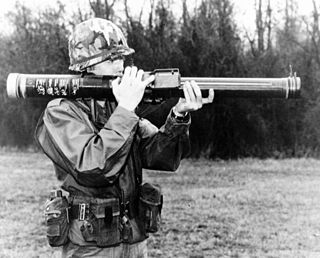
Anti-aircraft warfare, counter-air, anti-air, AA guns, layered air defence or air defence forces is the battlespace response to aerial warfare, defined by NATO as "all measures designed to nullify or reduce the effectiveness of hostile air action". It includes surface based, subsurface, and air-based weapon systems, associated sensor systems, command and control arrangements, and passive measures. It may be used to protect naval, ground, and air forces in any location. However, for most countries, the main effort has tended to be homeland defence. NATO refers to airborne air defence as counter-air and naval air defence as anti-aircraft warfare. Missile defence is an extension of air defence, as are initiatives to adapt air defence to the task of intercepting any projectile in flight.

Anti-tank warfare originated from the need to develop technology and tactics to destroy tanks during World War I. Since the Allies deployed the first tanks in 1916, the German Empire developed the first anti-tank weapons. The first developed anti-tank weapon was a scaled-up bolt-action rifle, the Mauser 1918 T-Gewehr, that fired a 13.2 mm cartridge with a solid bullet that could penetrate the thin armor of tanks at that time and destroy the engine or ricochet inside, killing occupants. Because tanks represent an enemy's strong force projection on land, military strategists have incorporated anti-tank warfare into the doctrine of nearly every combat service since. The most predominant anti-tank weapons at the start of World War II in 1939 included the tank-mounted gun, anti-tank guns and anti-tank grenades used by the infantry, and ground-attack aircraft.

The 8.8 cm Flak 18/36/37/41 is a German 88 mm anti-aircraft and anti-tank artillery gun, developed in the 1930s. It was widely used by Germany throughout World War II and is one of the most recognized German weapons of the conflict. The gun was universally known as the Acht-acht ("eight-eight") by the Germans and the "eighty-eight" by the Allies. Due to its lethality, especially as a tank killer, the eighty-eight was greatly feared by Allied soldiers.

The Type 88 75 mm AA gun was an anti-aircraft gun used by the Imperial Japanese Army during the Second Sino-Japanese War and World War II. The Type 88 number was designated for the year the gun was accepted, 2588 in the Japanese imperial year calendar, or 1928 in the Gregorian calendar. It replaced the earlier Type 11 75 mm AA gun in front line combat service, and at the time was equal in performances to any of its contemporaries in western armies and was considered capable of handling any targets the Japanese army was likely to encounter on the Asian mainland. Although it was soon overtaken by improvements in aircraft technology and was largely obsolete by 1941, it continued to be used on many fronts until the end of the war.

The Type 96 25 mm gun was an automatic cannon used by the Imperial Japanese Navy during World War II. A locally-built variant of the French Hotchkiss 25 mm anti-aircraft gun, it was designed as a dual-purpose weapon for use against armored vehicles and aircraft, but was primarily used as an anti-aircraft gun in fixed mounts with one to three guns.

The Flak 30 and improved Flak 38 were 20 mm anti-aircraft guns used by various German forces throughout World War II. It was not only the primary German light anti-aircraft gun but by far the most numerously produced German artillery piece throughout the war. It was produced in a variety of models, notably the Flakvierling 38 which combined four Flak 38 autocannons onto a single carriage.

The 3.7 cm Flak 18/36/37 was a series of anti-aircraft guns produced by Nazi Germany that saw widespread service in the Second World War. The cannon was fully automatic and effective against aircraft flying at altitudes up to 4,200 m. The cannon was produced in both towed and self-propelled versions. Having a flexible doctrine, the Germans used their anti-aircraft pieces in ground support roles as well; 37 mm caliber guns were no exception to that. With Germany's defeat, production ceased and, overall, 37 mm caliber anti-aircraft cannon fell into gradual disuse, being replaced by the Bofors 40 mm gun and later, by 35-mm anti-aircraft pieces produced in Switzerland.

Bofors 75 mm and Bofors 80 mm were two closely related designs of anti-aircraft and general-purpose artillery. Less well known than the 40 mm quick-firing AA gun, the gun was nevertheless adopted by armed forces of numerous countries during World War II, including Argentina, China, Dutch East Indies, Finland, Greece, Hungary, Persia and Thailand. It was closely related to the 8.8 cm Flak 18/36/37/41, one of the best-known AA guns of World War II, which was partially based on it. Some pieces captured by the Japanese in China served as the blueprint for the Type 4 75 mm AA Gun, a reverse-engineered clone of the Bofors 75mm gun.
The First Indochina War involved the North Vietnam or Việt Minh (Army: People's Army of Vietnam (PAVN), Lao Issara (1945–1949), Pathet Lao (1949–1954), Lao People's Armed Forces (LPAF), Khmer Issarak or United Issarak Front (1950–1954)), Japanese volunteers, the State of Vietnam (1949–1954) and the French Fourth Republic (Army: French Armed Forces (Forces armées Françaises) or French Indochina, French Far East Expeditionary Corps (Corps Expéditionnaire Français en Extrême-Orient(CEFEO)), Kingdom of Cambodia (1946–1954), Kingdom of Laos (1947–1954), Vietnamese National Army (VNA)).